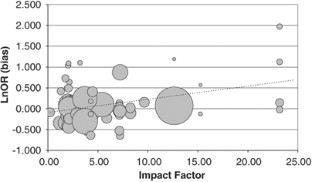Bias in genetic association studies and impact factor (original) (raw)
- Letter to the Editor
- Published: 21 January 2009
Molecular Psychiatry volume 14, pages 119–120 (2009)Cite this article
- 3042 Accesses
- 32 Altmetric
- Metrics details
Studies reporting correlations between genetic variants and human phenotypes, including disease risk as well as individual differences in quantitative phenotypes such as height, weight or personality, are notorious for the difficulties they face in providing robust evidence.1 Notably, in many cases an initial finding is followed by a large number of attempts at replication, some positive, some negative.2, 3, 4, 5 Although there has been debate over the statistical arguments concerning the strength of evidence in association studies,1 there has been less interest in understanding why it is that some genetic associations generate such large literatures of inconclusive results. We wondered whether one source of the difficulties in the interpretation of genetic association studies might lie with the journal that published the initial finding. Studies published in journals with a high impact factor typically attract considerable attention. However, it is not clear that these studies are necessarily more robust than those published in journals with lower impact factors.
We used data from three meta-analytic reviews of gene–disease associations in the psychiatric genetics literature, resulting in a total of _k_=81 studies published between 1990 and 2008. We divided the individual study odds ratio (OR) by the pooled OR, to arrive at an estimate of the degree to which each individual study over- or underestimated the true effect size, as estimated in the corresponding meta-analysis. We have recently used this method to identify a biasing effect of research location and resources.6 Additional data on the impact factor of the journal in which each individual study was published were collected, using 2006 data. These data were unavailable in the case of two studies, resulting in a final sample of _k_=79 studies.
This is a preview of subscription content, access via your institution
Relevant articles
Open Access articles citing this article.
Access options
Subscribe to this journal
Receive 12 print issues and online access
$259.00 per year
only $21.58 per issue
Buy this article
- Purchase on SpringerLink
- Instant access to full article PDF
Prices may be subject to local taxes which are calculated during checkout
Additional access options:
Figure 1

References
- Chanock SJ, Manolio T, Boehnke M, Boerwinkle E, Hunter DJ, Thomas G et al. Nature 2007; 447: 655–660.
Article CAS Google Scholar - Blum K, Noble EP, Sheridan PJ, Montgomery A, Ritchie T, Jagadeeswaran P et al. JAMA 1990; 263: 2055–2060.
Article CAS Google Scholar - Lesch KP, Bengel D, Heils A, Sabol SZ, Greenberg BD, Petri S et al. Science 1996; 274: 1527–1531.
Article CAS Google Scholar - Munafo MR, Freimer NB, Ng W, Ophoff R, Veijola J, Miettunen J et al. Am J Med Genet B Neuropsychiatric Genet 2008; e-pub ahead of print.
- Munafo MR, Matheson IJ, Flint J . Mol Psychiatry 2007; 12: 454–461.
Article CAS Google Scholar - Munafo MR, Attwood AS, Flint J . Psychol Med 2008; 38: 1213–1214.
Article Google Scholar
Author information
Authors and Affiliations
- Department of Experimental Psychology, University of Bristol, Bristol, UK
M R Munafò & G Stothart - Wellcome Trust Centre for Human Genetics, University of Oxford, Oxford, UK
J Flint
Authors
- M R Munafò
You can also search for this author inPubMed Google Scholar - G Stothart
You can also search for this author inPubMed Google Scholar - J Flint
You can also search for this author inPubMed Google Scholar
Corresponding author
Correspondence toM R Munafò.
Rights and permissions
About this article
Cite this article
Munafò, M., Stothart, G. & Flint, J. Bias in genetic association studies and impact factor.Mol Psychiatry 14, 119–120 (2009). https://doi.org/10.1038/mp.2008.77
- Published: 21 January 2009
- Issue Date: February 2009
- DOI: https://doi.org/10.1038/mp.2008.77